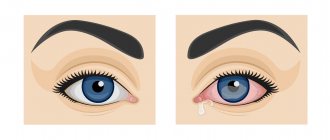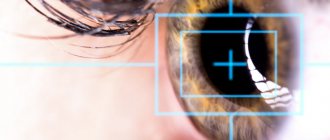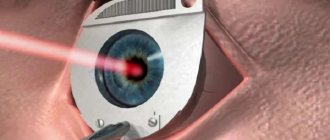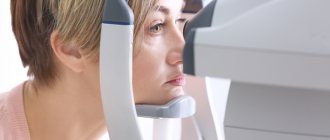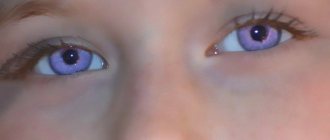What is presbyopia (age-related farsightedness)
In order to see at different distances, the human eye changes the curvature of the lens located inside the eye using special muscles.
By the age of 40, the muscles of the eye begin to weaken due to natural aging processes.
causing the eye to lose its ability
to see well up close.
This is presbyopia (known in everyday life as age-related farsightedness).
Normal eye
In a normal eye, light is focused on the retina; the owner of such a healthy eye sees objects clearly at any distance
Presbyopic eye
Due to weakened eye muscles, the eyes are unable to focus light on the retina, causing nearby
to appear blurry
Modern correction using the LASIK Supracor method
Would you like to read freely, work on a computer or smartphone, get rid of the need to care for glasses and lenses, regularly buy new ones, surprise everyone with your rejuvenated appearance by giving up glasses?
The developers of Technolas Perfect Vision (Germany) have created a new effective and safe procedure for laser correction of presbyopia (age-related farsightedness) “Supracor” for the LASIK method, which has been successfully used by eye specialists for several years.
(Detailed general information about vision correction using the Femto-LASIK method is also available in the “Vision Correction” section).
What is the Supracor procedure?
“Supracor” is a special algorithm for the treatment of presbyopia (age-related farsightedness), developed by Technolas Perfect Vision (Germany) in 2010 for the “Technolas Excimer Workstation” equipment with which the eye is equipped.
The “Supracor” procedure is used during laser correction of presbyopia using the LASIK method and allows to obtain better results in comparison with the previous generation laser correction of presbyopia.
That is, simply put, after the Supracor procedure, the patient can see finer details of objects (and therefore text) than after the LASIK procedure using previous algorithms. Accordingly, the strain on the eyes when reading, working with a computer, etc. is reduced, which increases reading comfort, reduces the rate of eye fatigue, which generally improves the patient’s quality of life.
Equipment for presbyopia correction
The eye clinic is equipped with the latest equipment
"VICTUS Femtosecond Laser Platform" and "TECHNOLAS Excimer Workstation ZYOPTIX", which is manufactured in
Germany.
This choice is justified by two generations of equipment and numerous expansions and additions that have occurred in our eye center over more than 12 years. The majority of excimer lasers installed in the world are .
Our employees received additional training directly from specialists from the company’s German office.
stands at the origins of the ophthalmic excimer laser industry; numerous manufacturers of such equipment purchase the head laser module from .
Femtosecond laser “VICTUS Femtosecond Laser Platform” and excimer laser “TECHNOLAS Excimer Workstation ZYOPTIX” installed in the eye.
How is the treatment carried out?
The operation lasts approximately 15 minutes:
First, using the Victus femtosecond laser, a so-called flap is formed on the surface of the cornea.
Next, with the help of an excimer laser, a microscopic layer of tissue is evaporated, the volume of which is designed specifically to obtain the corneal curvature necessary for vision correction.
That is, we can say that the surface of the eye turns into a lens, which creates the desired correction.
A superficial flap on the cornea is formed in order to increase the safety of the operation, speed up the healing process, and improve the results obtained.
This allows you to see clearly almost immediately after the procedure, and unpleasant sensations (similar to those that occur when cleaning an onion) remain for only a few hours.
A special tracking system constantly monitors and follows the slightest fluctuations of the eye, fully controlling each point of influence of the laser beam, with the help of which ideal precision and accuracy of corneal profile correction are achieved, which, accordingly, gives an excellent correction result.
The Technolas Z100 Zyoptix excimer laser system also has special software that allows laser correction of farsightedness and presbyopia with a high degree of safety and efficiency, which is not available with a number of similar devices.
The core of this program is the direction of laser exposure to the periphery of the cornea using the double “scanning/flying spot” method, which achieves an increase in the optical power of the cornea in its center.
The advantage of the Technolas Z100 Zyoptix laser model is also the use of the Planoscan software package, which allows the laser to work in conjunction with a diagnostic station, including Orbscan and Zywave devices, with the help of which the doctor receives data on the smallest anatomical features of the patient’s cornea
and transmits this data directly to the laser.
Thus, the treatment takes into account the smallest details of the structure of each patient’s eye, thereby achieving the best treatment result.
The LASIK procedure is performed on an outpatient basis: the patient is observed in the clinic for an hour, and then can safely go home.
The very next day you can start work, watch TV, use a computer, drive a car and continue to lead a normal lifestyle.
There are only a few exceptions:
- Do not rub your eyes, take a steam bath or swim in a pool for 2 weeks
- Do not drink alcohol for 1 week after surgery
You should visit your doctor for postoperative examinations once a week for the first month after surgery.
In order to protect yourself during the postoperative period, you must:
- To protect against infections, instill Tobrex antibiotics for 1 week
- to improve healing and prevent unwanted dry eye from antibiotics, instill Oquis 0.3% for 1-2 months
Presbyopia - symptoms and treatment
Once the doctor has decided on the necessary addition for the patient, he can begin to choose the method of correction. There are several options to help a patient with presbyopia. The simplest way is glasses for working at close range , which will take into account the addition only at one given distance, familiar and necessary for a particular patient. For each person, the usual distance and the necessary addition are strictly individual, so using “ready-made glasses” purchased on the market is not the right choice. It is better to go to an optician, where a qualified optometrist or doctor will select the correction necessary in this case [7].
Another method of correction is glasses with bifocal lenses , in which there are only two focal lengths: distance and 40-50 cm. These glasses can make distance and near vision clearer, but they do not take into account vision at an average distance. glasses with progressive lenses are considered a more physiological alternative . They provide good visual acuity at distance, mid-distance and near.
Selecting glasses with progressive lenses is more difficult: you need to take into account not only the full distance correction and the necessary addition, but also the specific fit of the frame on the patient’s face. Therefore, after writing out the prescription, it is necessary to mark the selected frame, take into account the distance from the patient’s eye to the lens and the pantoscopic angle - the angle of inclination of the frame relative to the patient’s eyes.
The transition of refractive power from distance to near in such lenses is smooth and as comfortable as possible for the eyes, but nevertheless, a certain skill in using such glasses is necessary and comes with experience.
There are various options for progressive spectacle lenses . One of them takes into account good visual acuity in the distance and at a distance of 40-50 cm. It is more suitable for drivers and patients with moderate and high farsightedness. Others are designed for good near vision for text or computer work, as well as clear distance and intermediate vision, such as within an office (which is why they are called “office lenses”). They are suitable for people with normal vision, patients with myopia or mild farsightedness.
There are so-called “accommodation-supported” lenses, which provide a weak addition of up to 1.0 diopters. They are designed to relieve accommodation at close range in people with unexpressed presbyopia, but who work a lot with a computer and complain of discomfort and eye fatigue. Such lenses can be used even by children if they have PINA (habitual excess tension of accommodation) or spasm of accommodation.
The choice of correction depends on the main type of human activity. Each lens manufacturing company tries in its own way to improve the quality of vision using the products they offer, so the choice of such correction is quite wide [8].
The next possible way to correct presbyopia could be contact lenses , the design of which also takes into account visual acuity at far, intermediate and near distances. The selection of lenses is no different from the selection of progressive glasses, but there are some peculiarities.
There are two ways to correct presbyopia using contact lenses:
- monovisual correction;
- selection of bifocal and multifocal contact lenses.
Monovisual correction is a correction method when one of the lenses is selected for distance vision, and the other for near vision. Suitable for patients with initial manifestations of presbyopia who have previously used contact lenses, as well as if visual work occurs at medium distances - more than 40 cm. All subtleties of selection are taken into account in each specific case.
Bifocal and multifocal contact lenses are divided into alternating and simultaneous. Alternating contact lenses have two zones: one is intended for near and is located in its lower segment, the other is intended for distance and is located in the center. Vision stabilization is achieved using prismatic ballast in the lower part of the lens, which does not allow it to move to the side, or by cutting off the edge of the lens in the lower zone. Typically this design is used to create hard contact lenses. Soft alternating contact lenses are not widely used because the increased displacement required to achieve visual comfort causes an unpleasant foreign body sensation or discomfort in the patient.
In simultaneous contact lenses, the distance and near zones are concentrically located in the plane of the pupillary zone, so the lens has different optical powers in the pupillary region. These contact lenses simultaneously project two images onto the retina. The patient's brain selectively suppresses the most unclear image.
Among all the methods of correcting presbyopia with contact lenses, monovisual correction is considered the simplest. As a rule, the patient continues to wear his usual contact lenses, and a lens is selected for one eye taking into account the required addition. This correction is effective for the initial manifestations of presbyopia. Further, with increasing addition, the difference in distance visual acuity between the right and left eyes becomes greater, binocular vision begins to suffer greatly, the patient experiences discomfort and therefore refuses monovisual correction.
Despite the fact that many bifocal and multifocal contact lenses are now being produced to correct presbyopia, a lens that is most comfortable for near and distance has not yet been created. Therefore, in case of negative experience when selecting one type of lenses, it is advised to try to select lenses of a different design [9].
A radical way to correct presbyopia is surgical treatment - laser vision correction using PresbyMAX technology . More than 11,000 procedures have been successfully performed worldwide using this method. PresbyMAX Hybrid provides varying depth of focus at distance and near the eye.
The main distinguishing feature of the operation is that during the intervention it is possible to create a shape of the cornea that can be compared to multifocal lenses. Approximately 70% of patients after such an intervention can completely stop using glasses or contacts.
The operation is performed under local anesthesia. The effect occurs immediately after its implementation. Preparation for surgery requires a more thorough diagnosis by the surgeon [10].
Recovery time varies from person to person: some patients feel well within a week, while others need several months to fully adapt (usually up to one month).
Postoperative complications
Failure to follow the doctor’s recommendations after surgery can negate all the surgeon’s efforts: there is a danger of developing inflammation of the cornea (keratitis), conjunctiva (conjunctivitis), inflammation of the vascular tract of the eye (uveitis), even clouding of the cornea and permanent vision loss. An experienced ophthalmologist will be able to solve them, but it is better not to violate the prescribed recommendations.
Implantation of an intraocular lens
It is often advisable to use another approach to correction - phacoemulsification of the lens with implantation of an intraocular lens
(that is, replacing the native lens with an artificial one).
New generation artificial lenses - Acrysof Restor produced by Alcon Corporation (USA) have several focuses, which allows the patient who has such a lens implanted to see near and far without glasses.
The advantage of this method is that by the age of 50, most people’s own lens becomes cloudy - a cataract occurs, which still has to be removed using phacoemulsification and the lens also replaced with an intraocular lens.
And at an earlier age, surgery is safer,
Since a clear lens is easier to replace, the risk of complications is lower, also due to the fact that a younger body is more resilient.
More information about phacoemulsification can be found in the section on cataract treatment.
Excellent distance vision and reading glasses
With age, a person who has worn glasses all his life, no matter “plus” or “minus”, understands that the time has come to buy another one - for reading.
Two pairs of different glasses is already too much! It is not too late to have excellent distance vision at any age, because our specialists have the most modern technologies. Laser vision correction or replacing the lens with an intraocular lens will return 100% distance vision, and a pair of reading glasses will be selected in accordance with the age norm.
This correction option is simple and most convenient. Distance vision remains unchanged, no matter how long it takes, and the lenses of the glasses can be changed occasionally as needed.
Correcting presbyopia in the future
The newest method for correcting presbyopia was presented at the congress of the European Society of Cataract and Refractive Surgeons in 2007.
The essence of the new method is to implant a small lens into the layers of the cornea of one eye, without penetrating the inside of the eye, which makes this operation extremely safe.
On the 3-4th day after surgery, the patient can already read, while binocular vision does not deteriorate.
This technique of placing a lens from +1 to +3.5 diopters into the cornea is also attractive for its simplicity.
A special device forms a 2.5 mm wide tunnel in the layers of the cornea, into which this lens with a diameter of 2.5 mm is placed through a special 1.5 mm wide tube.
Such an operation lasts only a few seconds, has the highest level of safety and a minimum likelihood of complications.
Subsequently, the implanted lens can be easily changed if more correction is needed with age.
But so far this method is only at the implementation stage and is not yet available in many countries, including Russia.
Other treatments for presbyopia
Methods of the past
PRK, LASEK, EPI-LASIK
In the 80s, ophthalmologists Pollikaris (Greece) and Burrato (Italy) developed a method of laser vision correction, in which the radius of curvature of the cornea is changed using a laser, as a result of which the image moves to the retina.
When performing an operation using this method, the laser beam acts on the surface layers of the cornea and “evaporates” the cornea until the required curvature is achieved.
As a result of such exposure, the surface layer of the cornea, which performs important protective functions - Bowman's membrane, is inevitably damaged.
Due to such damage, the recovery period is delayed, creating the potential for various complications to arise, and various side effects arise, for example, a halo around luminous objects, deterioration of twilight vision.
The LASEK and EPI-LASIK methods can be called a variation of the PRK method, since their use also causes damage to Bowman's membrane and, in general, does not eliminate the disadvantages of the PRK method.
"Super LASIK" and others
Among laser vision correction services, in addition to LASIK (LASIK), there are also other names,
in particular, “Super LASIK”, “Ultra LASIK”, “REIK”, etc. These are designations that clinics use to emphasize their nuances of the LASIK technique or their equipment.
“Super-LASIK” is not used in the medical literature ; it is more of an advertising origin; we can only note that the experience, professionalism of specialists, as well as the quality of eye care services, our techniques and equipment fully correspond to the level of the most modern and advanced medical institutions and, without any doubt, the popular name “Super-LASIK”.
Surgical methods
Today, it is possible to successfully correct presbyopia using the latest surgical methods. These are modern seamless technologies that came to us from Europe. The operations are performed on an outpatient basis, do not require deep anesthesia (only local anesthesia), and have a minimal recovery period.
All you need to do is undergo a complete vision diagnostics. At the final consultation, the ophthalmic surgeon will offer the most suitable surgical option in a particular case, taking into account the patient’s professional activities and even existing hobbies.

